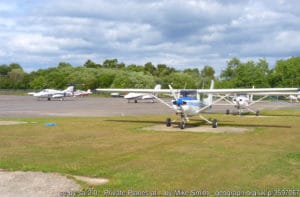Support us from £3/month
We deal with almost 1000 cases a year assisting communities, groups and individuals in protecting their local spaces and paths in all parts of England and Wales. Can you help us by joining as a member?
We are dismayed that a planning inspector has ruled that part of Yateley Common in Hampshire should lose its common-land status.
Mr Alan Beckett was the inspector at the public inquiry in April into Blackbushe Airport Ltd’s application to deregister nearly half a square kilometre of common land covering the airport. He has said that the common should be removed from the register—which would result in the land losing its protection from development.

Photo caption: Blackbushe airfield. This is part of the hardstanding on Yateley Common which is alleged to be the curtilage of the control tower. Photo: © Mike Smith, Creative Commons Licence.
The post-war history of Yateley Common is one of conflict between the peaceful use of the common for recreation and nature conservation, and the retention and expansion of wartime aerodrome facilities. Yateley Common, including much of the aerodrome, was rightly registered as common land in March 1975 under the Commons Registration Act 1965 by Commons Commissioner Baden Fuller, but before and after, the aerodrome has continued to be developed notwithstanding its status as common land, and commoners’ rights to use it for grazing and other purposes.
More than half a century after its registration, Blackbushe Airport Ltd applied to deregister the airport land, by alleging that all of the land is ‘curtilage’ of the terminal building.[1]
The Open Spaces Society and common rightholder Peter Tipton were among the objectors. The society argued that Parliament provided for the deregistration of buildings and curtilage to deal with situations where not only a house or other building had long been on the common, but also an adjoining garden, yard or shed.
But at Blackbushe, the applicant claimed that 47 hectares of grassland, runway, taxiways and car parks were the ‘curtilage’ of the terminal building, which itself covers just one-twentieth of one per cent of the area sought to be deregistered. The inspector has agreed that ‘the operational area of the airport formed and forms the curtilage of the terminal building’ despite the significant distance between them. He found the airport lands appurtenant to the terminal building — even though it is plainly the other way round.
Says our case officer, Hugh Craddock: ‘We are deeply disturbed by the inspector’s decision. It sets a damaging precedent for the definition of “curtilage” which is bad for Yateley Common and could put many other areas of common land at threat of deregistration—with the consequent threat of development and loss of public and commoners’ rights.
‘We are therefore considering what steps we might take to rectify this decision, which has potentially far-reaching implications.’
Adds Peter Tipton: ‘One thousand years of history of a large chunk of Yateley Common disappears over of single signature. Given the undoubted lure of the development dollar how likely is it that Blackbushe Airport will continue in business?’
March 2021 case update here.
[1]Under paragraph 6 of Schedule 2 to the Commons Act 2006, application may be made to deregister common land which, at the time of its registration under the 1965 Act, and ever since, has been covered by a building or the curtilage of a building. The application was made by Blackbushe Airport Ltd to Hampshire County Council as the commons registration authority. The application was referred to the Planning Inspectorate acting on behalf of the Secretary of State for determination.
